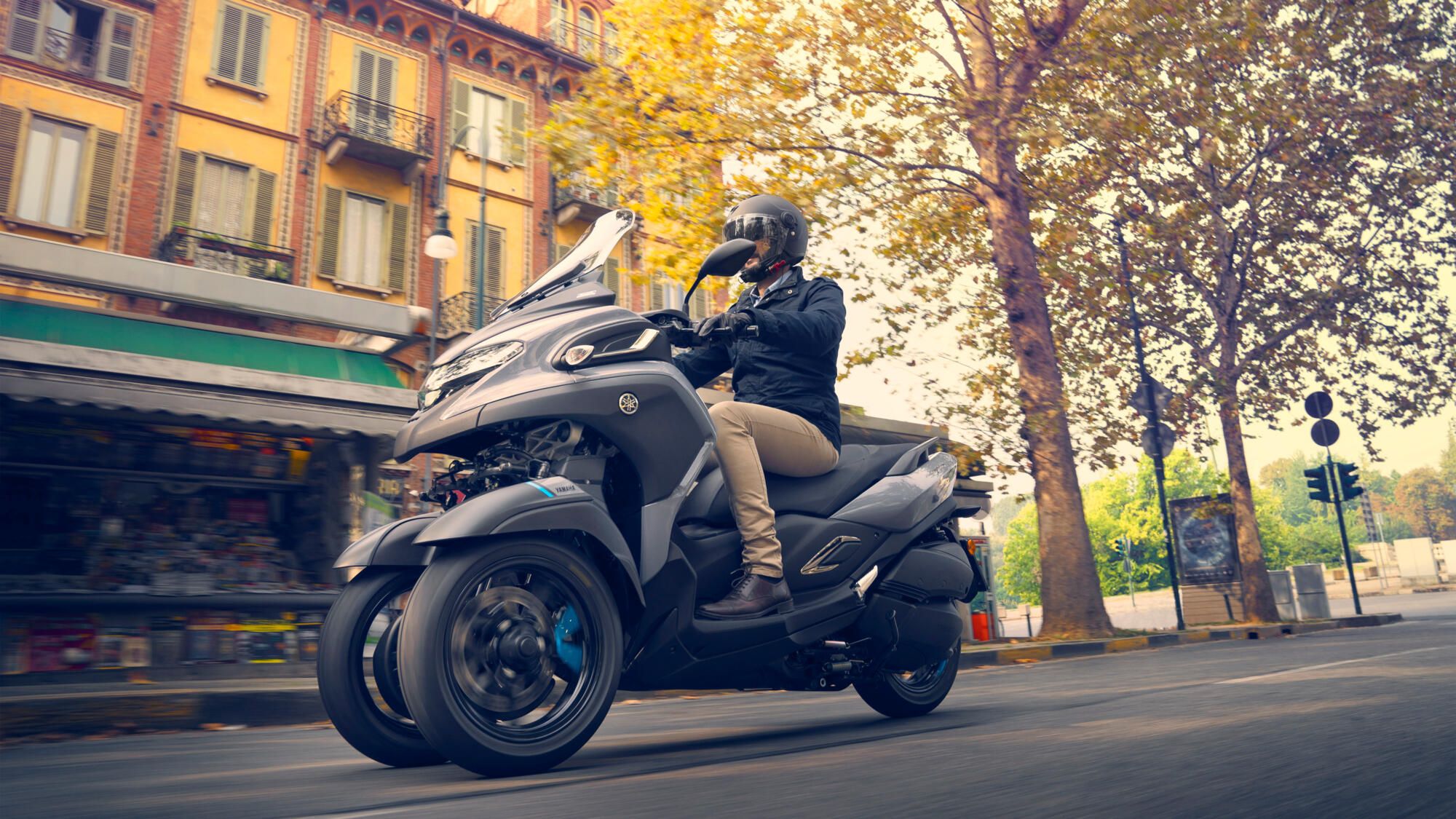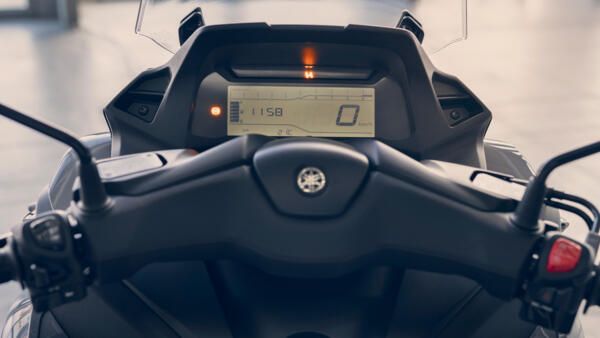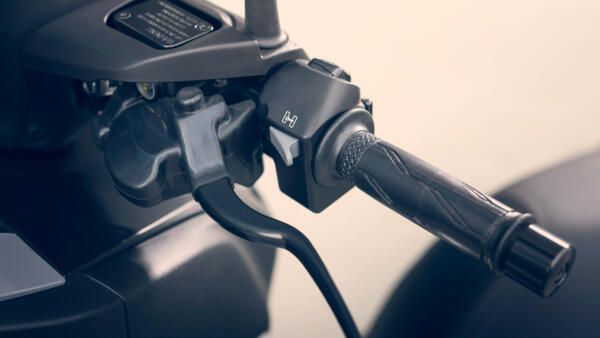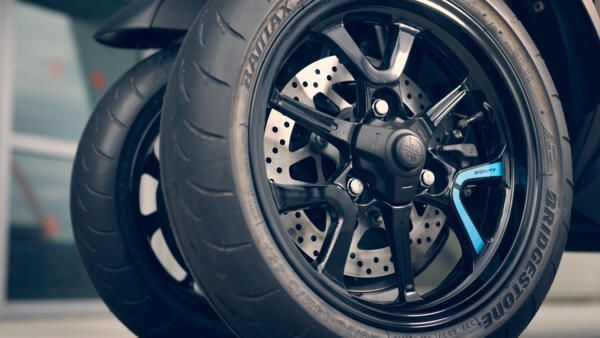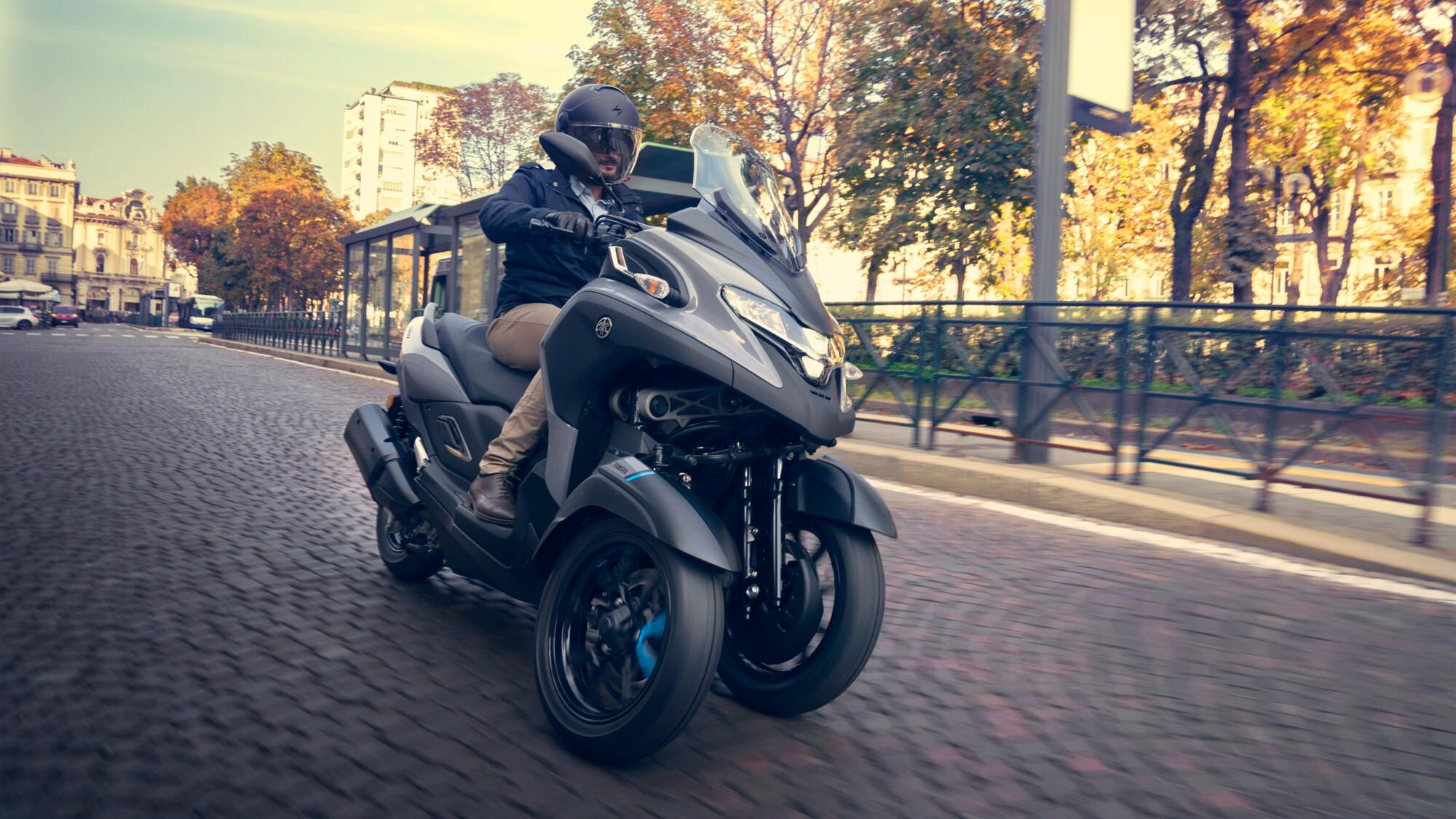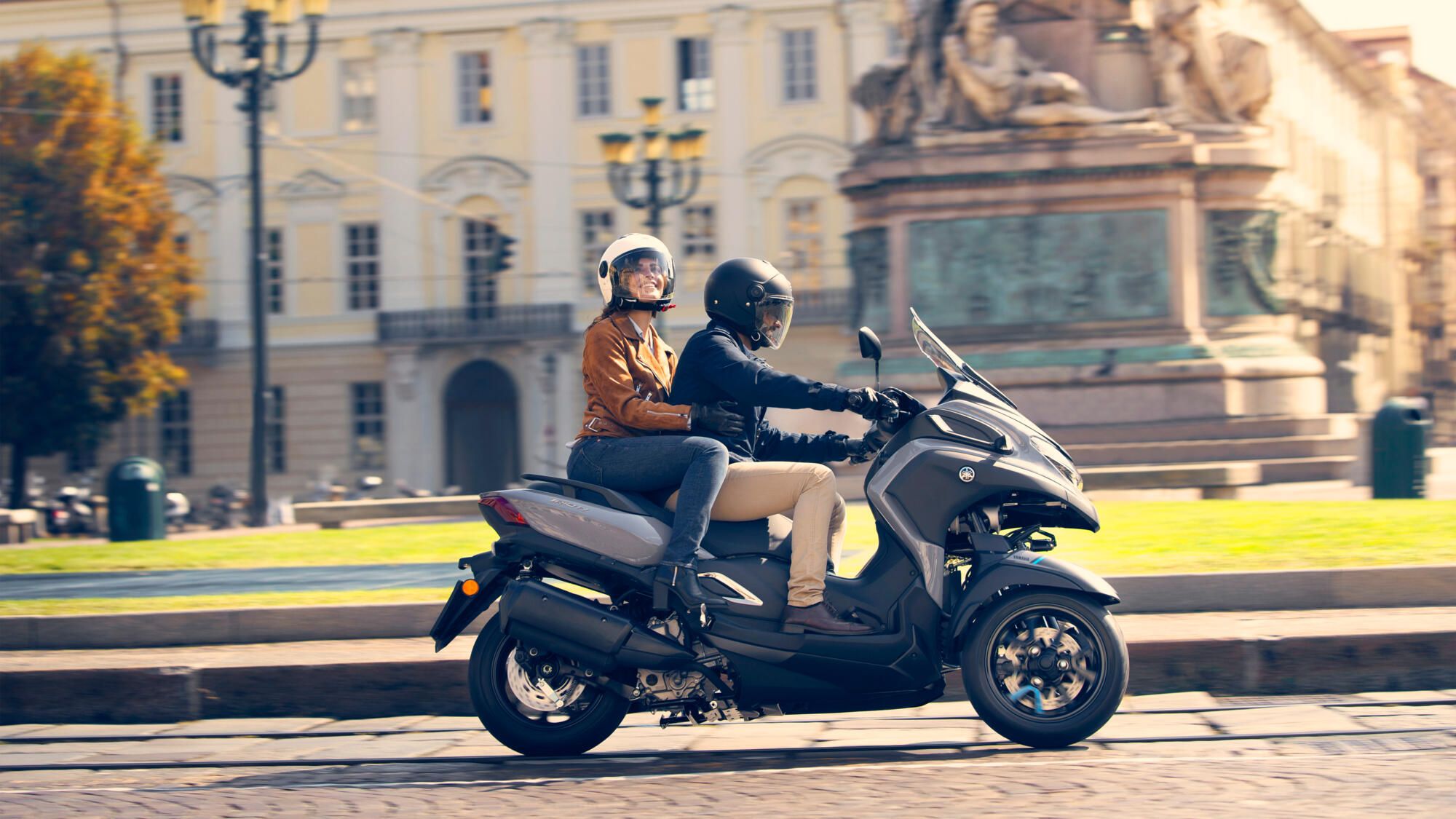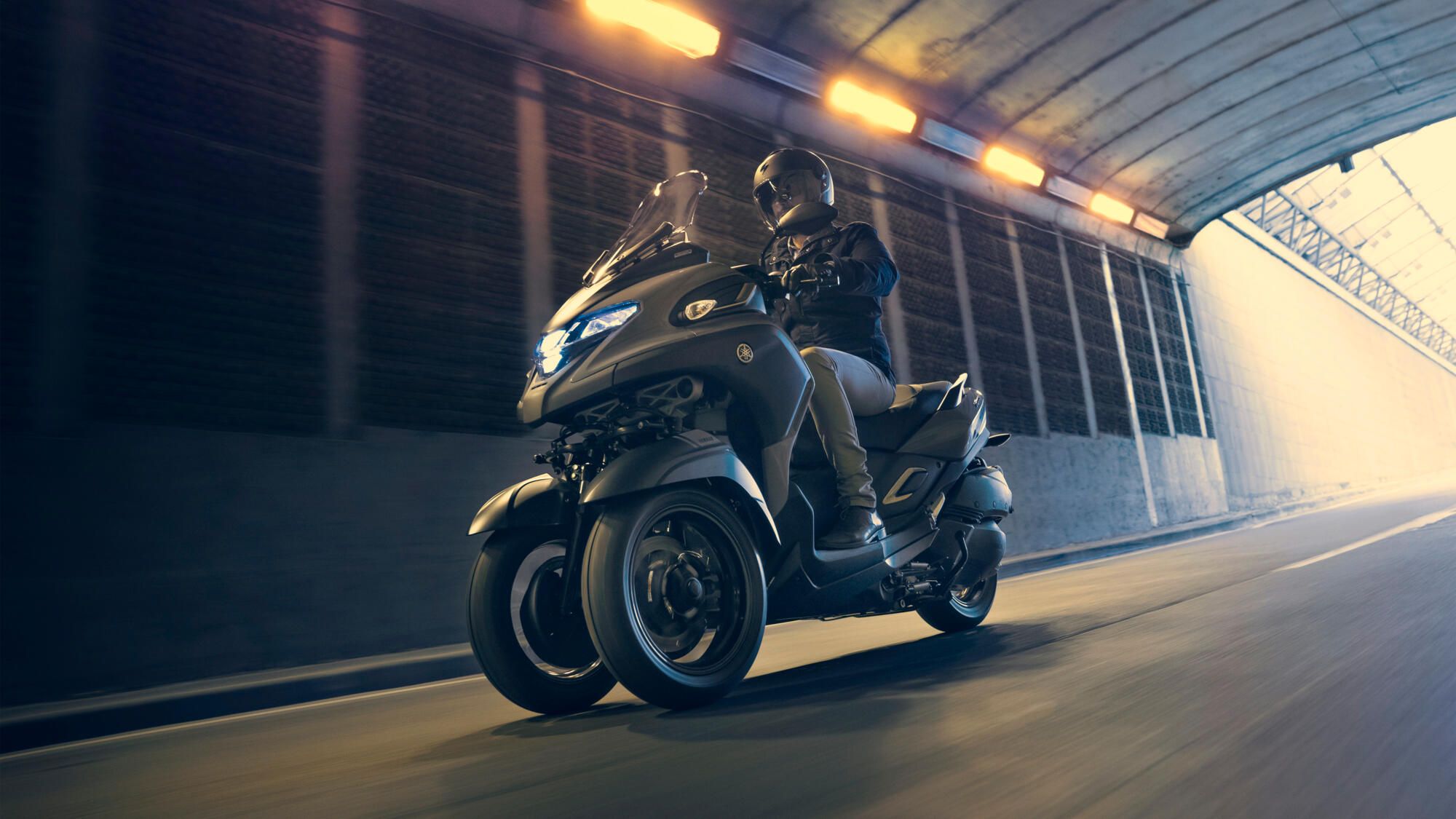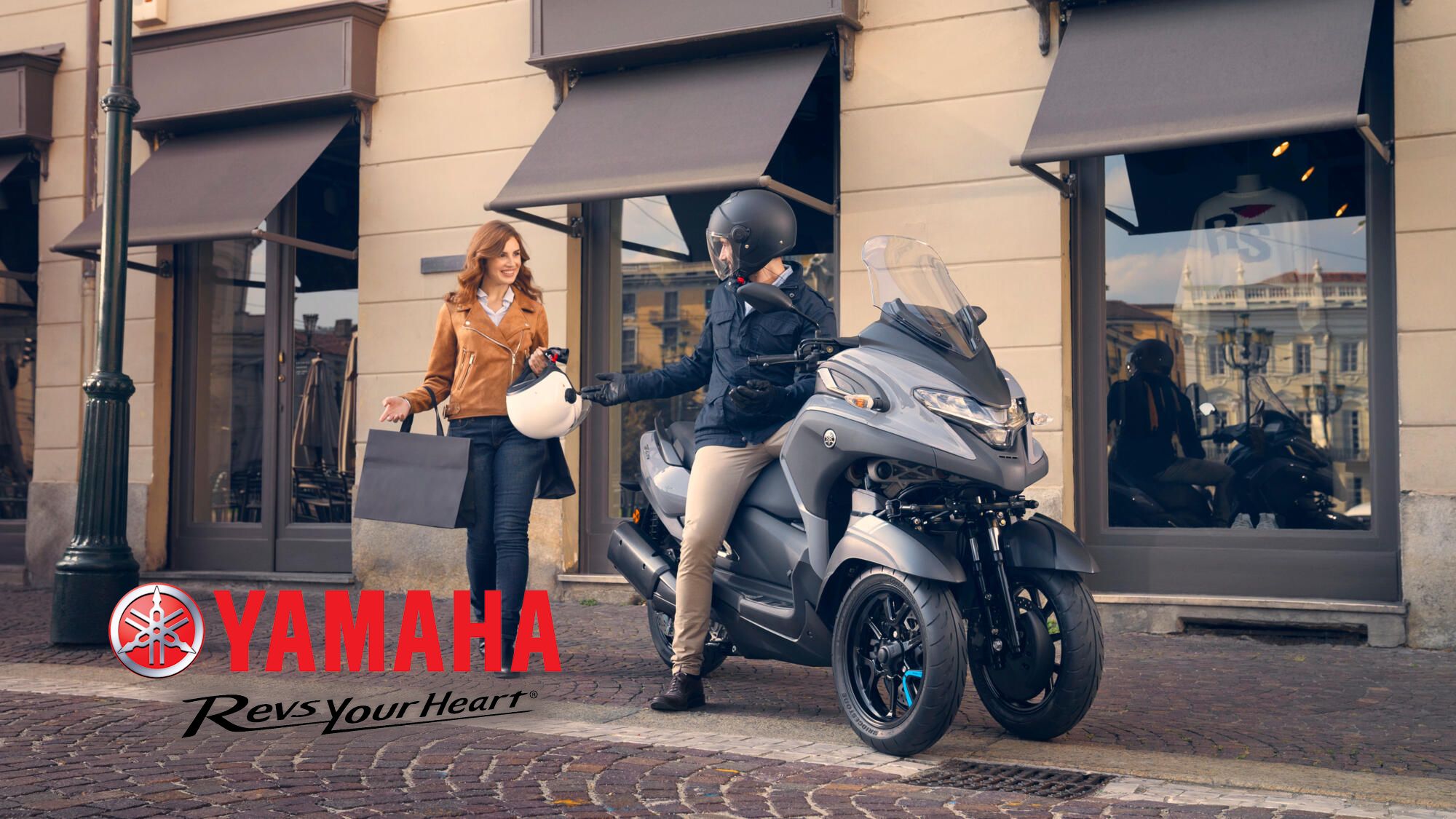Yamaha bills its Tricity 300 as an all-new model that accommodates a wide range of riders, including those who are clawing their way through the tiered-license nightmare found in places like GB and the EU. In the Tricity, find comfort in the stability inherent in three-wheel rides while retaining that feeling of flight we get when we lean into a corner. Best of all, the cleaner engine meets Euro-5 emissions requirements and turns out a top speed that should accommodate travel on any and all public roads, plus it can be driven with a full B car license.
Yamaha Tricity 300 Design
From the step-through on back, the Tricity's design is fairly typical for a scooter. A swing-drive system combines engine, transmission, and rear wheel in a single stressed assembly below a scooter-tastic subframe area. LED blinkers ride on the minimal tagholder that relies on the tag itself to complete the spray coverage. A wide pillion pad comes braced by beefy J.C. handles handles}} with flip-out footpegs to complete the passenger's amenities.
The sculpted front seat is cut away so as not to interfere with your ability to put your Lamborfeeties down. You don't necessarily always have to put your feet down though. The Standing Assist System locks up the front suspension so it becomes a self-supporting structure at stops if you'd rather not have to put at least one foot down, though it takes some timing to get it right.
Below the bench you'll find the usual under-seat storage locker, but this one is large enough to hold not one but two full-face buckets or a briefcase full-face buckets or a briefcase}}. This also makes it viable as a grocery-getter and errand-runner not to mention a campus commuter.
The front end departs from conventional design, but it kind of had to in order to accommodate the unusual leaning front-end mechanism. Wide enough to completely protect your legs and trunk, the “300” sports a vented windshield that extends the protection up to your head and shoulders. A short but wide headlight recess comes with more LED wizardry with fancy, standoff-style blinkers to finish out the front lighting and ensure good two-way visibility, day and night.
Around the backside of the front structure, the LCD instrument screen is joined by a small cubby that comes complete with a 12 Volt power outlet so you can charge your stuff while under way. If you're into cold/wet weather riding, the accessory catalog has lower-half protection and the Tricity 300 comes ready to receive heated handgrips.
Yamaha Tricity 300 Chassis
Much like Yamaha's Niken sportbike, the Tricity rides on dual paired telescopic forks – two to a side – with a parallelogram mechanism that acts like a tilting tripletree to make the real magic happen. Doubling the overall front contact patch area doesn't necessarily double the traction, but it certainly doesn't hurt. Plus, the dual front end is particularly effective on irregular surfaces such as cobblestone roads and when passing over railroads.
Suspension travel is fairly generous for a scooter with 3.93 inches of travel up front and 3.3 inches out back. Bear in mind that the front travel is representative of the travel in each fork pair. This is separate from the 40-plus degree lean angle provided by the fancy front end mechanism. Each of the three wheels comes with its very own 267 mm brake disc under the control of a linked-brake system that gives you a choice between using the front brakes alone or pressurizing all three for stability and control while braking, especially in the curves.
In spite of the alien front end, the Tricity provides a smooth ride that handles much like a two-wheeler even if the feedback at the bar is somewhat muted due to same. It isn't self supporting, so you are obliged to either put a foot down at stops or mash the Standing Assist System activation button to remain upright, and at no time will you feel limited in the curves like you might with a non-leaning trike model. Standing Assist System
|
It even responds to counter-steering inputs, so moving to a Tricity from a two-wheeler ride will come with a fairly flat learning curve. |
Double telescopic fork/ 3.9 inches (100 mm) |
|
Front suspension/ Travel: |
Unit Swing/ 3.3 inches (84 mm) |
|
Rear suspension/ Travel: |
Hydraulic disc brake, Ø267 mm |
|
Front brake: |
Hydraulic single disc brake, Ø267 mm |
|
Rear brake: |
120/70-14M/C 55P Tubeless |
|
Front tire: |
140/70-14M/C 62P Tubeless |
Yamaha Tricity 300 Drivetrain
Power for the Tricity 300 comes from a liquid-cooled thumper, to the tune of 27.6 horsepower at 7,250 rpm, backed up by 21.3 pound-feet of torque that comes on fully by 5,750 rpm. Slightly undersquare, the mill runs a 70 mm bore and 75.9 mm stroke for a total displacement of 292 cc and a spicy 10.9-to-1 compression ratio that will demand the top-hook fuel. It sends power through a centrifugal clutch and continuously-variable transmission for the expected twist-and-go operation so loved by the scootering community. And of course, all of the above is bolted up as a swing-mount unit that displaces part of the swingarm, and is another trait typical of the breed.
The top end rocks a single over-head cam that actuates a quartet of poppets for efficient aspiration and waste-gas removal. Electronic ignition and fuel-injection systems complete the base functions and help the mill meet its EU-5 emissions obligations. That doesn't tell the whole story, however, This machine comes with a stock traction control feature that helps to secure rear traction to match the solid tracking provided by the dual-wheel front end.
Combined, this makes the Tricity a very confidence-inspiring machine to ride, even for folks who are new to getting their fists in the wind. Top speed is a reported 85 mph, so it's a viable ride for folks who get on the superslab during their commute.
|
Engine: |
4-valves, 4-stroke, Single cylinder, Liquid-cooled, EURO5, SOHC |
|
Displacement: |
292 cc |
|
Bore x stroke: |
70.0 mm x 75.9 mm |
|
Compression ratio: |
10.9:1 |
|
Maximum power: |
27.6 hp (20.6 kW) @ 7,250 rpm |
|
Maximum torque: |
21.4 lb-ft (29.0 Nm) @ 5,750 rpm |
|
Lubrication system: |
Wet sump |
|
Fuel system: |
Fuel Injection |
|
Ignition system: |
TCI |
|
Starter system: |
Electric |
|
Transmission system: |
V-Belt Automatic |
Yamaha Tricity 300 Price
You can score yourself a Tricity 300 for a starting MSRP of £8,100 in 2022. The trio of paint packages are an exercise in understatement with monochromatic highlights in Petrol Blue, Sand Grey, or Gunmetal Grey over generous blackout treatment.
|
Color: |
|
|
└ 2021: |
Nimbus Grey, Tech Kamo, Gunmetal Grey |
|
└ 2022: |
Petrol Blue, Sand Grey, Gunmetal Grey |
|
Price: |
|
|
└ 2021: |
£7,802 |
|
└ 2022: |
£8,100 |
Yamaha Tricity 300 Competitors
To say that the field of backwards trike scooters is sparsely populated, especially among the big name brands, is an understatement, but I managed to find another apple in the MP3 300 Euro 5 from Italian giant Piaggio.
Piaggio MP3 300 hpe
It's clear that the Eye-Tie is vying for a slice of the very same market as its counterpart, and also that the factories in question took different routes to arrive at nearly the same place. A wide front end envelops and obscures the workings of the leaning mechanics to leave a little to the imagination, and of course ,this also makes for a wide legguard to protect your lower half from the weather. A smoked, vented windshield completes the coverage up top.
The liquid-cooled engine packs 278 cc with 25.8 horsepower and 19.25 pounds o' grunt against 27.6/21.3 to fall a skosh short in power delivery. Both bikes use some sort of front-suspension lockout device that makes them self-supporting at stops, and it looks like both ABS and traction control come stock across the board for a level of stability and safety that is uncommon among proper scooter models. Piaggio gets a minor win at the checkout with its £7,000 starting sticker.
Read our full review of the Piaggio MP3 300.
He Said
“What an interesting machine this is. It brings the convenience of twist-and-go operation to the table along with safety electronics that are enough to embarrass much larger machines, and more expensive ones at that. My main opposition to trikes is that most don't lean, or even worse, are the old two-in-back design that is inherently unstable, but Yamaha addresses both with the Tricity 300.”
She Said
My wife and fellow motorcycle writer, Allyn Hinton, says, “It's amazing the sensation of control and agility with this leany trike. It really feels sportbike-like when attacking the curves and the 40+ degree lean angle is just ridiculous. You forget it's a scooter, except for the ease of the twist-and-go operation.”
Yamaha Tricity 300 Specifications
|
Engine & Drivetrain: |
|
|
Engine: |
4-valves, 4-stroke, Single cylinder, Liquid-cooled, EURO5, SOHC |
|
Displacement: |
292 cc |
|
Bore x stroke: |
70.0 mm x 75.9 mm |
|
Compression ratio: |
10.9:1 |
|
Maximum power: |
27.6 hp (20.6 kW) @ 7,250 rpm |
|
Maximum torque: |
21.4 lb-ft (29.0 Nm) @ 5,750 rpm |
|
Lubrication system: |
Wet sump |
|
Fuel system: |
Fuel Injection |
|
Ignition system: |
TCI |
|
Starter system: |
Electric |
|
Transmission system: |
V-Belt Automatic |
|
Chassis: |
|
|
Front suspension/ Travel: |
Double telescopic fork/ 3.9 inches (100 mm) |
|
Rear suspension/ Travel: |
Unit Swing/ 3.3 inches (84 mm) |
|
Front brake: |
Hydraulic disc brake, Ø267 mm |
|
Rear brake: |
Hydraulic single disc brake, Ø267 mm |
|
Front tire: |
120/70-14M/C 55P Tubeless |
|
Rear tire: |
140/70-14M/C 62P Tubeless |
|
Dimensions & Capacities: |
|
|
Overall length: |
88.6 inches (2,250 mm) |
|
Overall width: |
32 inches (815 mm) |
|
Overall height: |
57.9 inches (1,470 mm) |
|
Seat height: |
31.3 inches (795 mm) |
|
Wheelbase: |
62.8 inches (1,595 mm) |
|
Minimum ground clearance: |
5.1 inches (130 mm) |
|
Wet weight: |
526.9 lbs (239 kg) |
|
Fuel tank capacity: |
3.4 gals (13 L) |
|
Fuel consumption: |
71.3 mpg (3.3 l / 100 km) |
|
Details: |
|
|
Color: |
|
|
└ 2021: |
Nimbus Grey, Tech Kamo, Gunmetal Grey |
|
└ 2022: |
Petrol Blue, Sand Grey, Gunmetal Grey |
|
Price: |
|
|
└ 2021: |
£7,802 |
|
└ 2022: |
£8,100 |
Further Reading
Yamaha
Read more Yamaha news.

